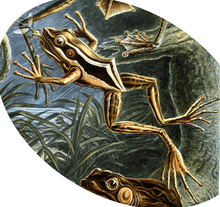- Common green frog
-
Hylarana erythraea 
From Ernst Haeckel's Kunstformen der Natur Conservation status Scientific classification 
Kingdom: Animalia Phylum: Chordata Class: Amphibia Order: Anura Family: Ranidae Genus: Hylarana Species: H. erythraea Binomial name Hylarana erythraea
(Schlegel, 1837)Synonyms Several, see text
The common green frog (Hylarana erythraea) is a frog species of in the true frog family Ranidae of superfamily Ranoidea; some sources still use the old name Rana erythraea. It lives in Southeast Asia and is also known as green paddy frog, red-eared frog or leaf frog.[1]
The last name, however, commonly refers to the Neotropical tree frogs which make up the subfamily Phyllomedusinae. These are not closely related to H. erythraea, belonging to family Hylidae in superfamily Hyloidea instead.
Contents
Taxonomy and systematics
Long placed in Rana, it is only as closely related to this genus as is e.g. Amolops. Consequently the genus Hylarana, of which the common green frog is the type species, warrants re-establishment. Hylarana seems to form a clade together with the similarly revalidated genera Pulchrana and Sylvirana, and presumably also Hydrophylax as well as some species presently placed in Pelophylax (e.g. Kokarit Frog, "P." lateralis).[2]
This frog has confused researchers for a long time, as it resembles tree frogs in habitus. It was initially placed in the tree frog genus Hyla. The junior synonyms of the common green frog are:
- Hyla erythraea Schlegel, 1837
- Hylorana erythraea (lapsus)
- Limnodytes erythraeus (Schlegel, 1837)
- Polypedates erythraea (Schlegel, 1837)
- Rana erythraea (Schlegel, 1837)
Distribution and ecology
H. erythraea occurs in Brunei, Cambodia, Indonesia, Laos, Malaysia, Myanmar, Singapore, Thailand, and Vietnam. Introduced populations are found on Sulawesi and the Philippines. The similar frogs from northeastern India and adjacent regions, formerly included here, are now separated as Hylarana tytleri.[1]
Its natural habitats are subtropical or tropical moist lowland forests, subtropical or tropical moist montane forests, freshwater lakes, intermittent freshwater lakes, freshwater marshes, intermittent freshwater marches, rural gardens, heavily degraded former forest, irrigated land, seasonally flooded agricultural land, and introduced vegetation.[1]
Footnotes
References
- "Hylarana erythraea". IUCN Red List of Threatened Species. Version 2011.1. International Union for Conservation of Nature. 2011. http://www.iucnredlist.org/apps/redlist/details/58593. Retrieved 30 August 2011.
- Stuart, Bryan L. (2008): The phylogenetic problem of Huia (Amphibia: Ranidae). Mol. Phylogenet. Evol. 46(1): 49-60. doi:10.1016/j.ympev.2007.09.016 PDF fulltext
External links

This true frog article is a stub. You can help Wikipedia by expanding it.

